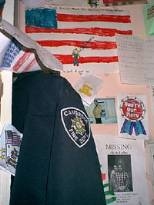Nine months of round-the-clock work to clear the devastated World Trade Towers site in New York was completed last Friday. As the last steel beam was to be hauled away, MIT's Gayle C. Willman, faculty liaison in Academic Media Production Services and author of this account, looked back over her experiences as one of more than 120 volunteers who supported construction crews in the cleanup efforts.
Willman was not alone. Volunteers from the MIT community contributed more than 1,000 hours in five different trips to Ground Zero. Between Thanksgiving 2001 and Memorial Day 2002, they delivered boots, Chapstick and Easter baskets, served meals in the middle of the night, kept flowers fresh and candles burning.
Two weeks ago, I was taken into The Pit for the first time. One of the firefighters pointed out where things had been--the PATH train, the shopping plaza, the parking garage, Buildings 4, 5, 6 and 7 ... the South Tower, the North Tower. It was hard to imagine, with nothing left but distant workers, a faraway 10 stories below street level.
A powerful moment for reflection was interrupted by a shout: "Where's your hat?"
My companion grinned. "Nice going. You're not even here for five minutes and the chief is yelling at you." He pointed to a pile of neon orange hard hats. "You'd better put one on." After months of seeing workers and volunteers "rescue" each other from the brink of almost unbearable sadness, I had to smile. I had just been rescued.
With hard hat in place, I was left alone to consider the view. News footage never gave us a sense of the vastness of this dusty gray canyon in the middle of downtown Manhattan.
TAKING ACTION
Last fall, the tragedy and destruction of Sept. 11 was on everyone's mind. In addition to contributing money, so many people wanted to do something. So we did.
Melinda G. Cerny, project manager in the Center for Advanced Educational Services, and Mary K. Curtin, administrative assistant in Academic Media Production Services (CAES), collected blue jeans, shirts and other clothing through a campus drive on behalf of our local fire station. Then the MITAC office suggested that those going on an annual MITAC pre-holiday trip to New York City each bring a gift for workers.
We decided to piggyback on that trip. MIT Campus Police Sgt. Cheryl Vossmer launched an e-mail campaign to raise funds for work boots. MIT employees donated enough money to buy 22 pairs of steel-toe work boots. At CAES, administrative officer Deirdre A. Dow-Chase raised enough money to buy 13 dozen pairs of socks, with funds to spare. The cargo bin in our first bus was full.
Once we got to New York, the MITAC bus driver took us downtown to St. Paul's, the chapel at the edge of Ground Zero. A frowning N.Y.P.D. officer approached, saying, "You can't stop here."
"Wait!" I said. "We have work boots." I opened the first cargo bin. "See?"
The frown immediately became a smile. "Oh! Okay."
The police officers cleared a path through the crowd, so our 38 MIT volunteers could carry donations into the church.
The boots were especially needed. The eight-story pile of twisted steel and debris was still smoldering after two months, and the heat was melting the soles on the workers' boots.
Once inside, we learned there was a waiting list for boots. One recipient did an impromptu dance, singing "I Have Happy Feet." Another insisted we take a picture of his feet in the new boots.
Overall, the fuss was disconcerting. Boots meant that much? Worker after worker came over to thank us, several saying, "Thank you for remembering us."
THE LITTLE CHAPEL THAT STOOD
The oldest public building in Manhattan, St. Paul's, is the church where George Washington worshipped during his presidency. Known more recently as "the little chapel that stood," it's located at the edge of The Pit but survived the devastation of Sept. 11 without damage.
In January, the first of a series of MIT volunteer groups went to St. Paul's. Cranes were still lifting debris and smoke still poured from the pile. Rescuers were sleeping in pews or on cots. Volunteers served hot meals and coffee or worked in the tiny kitchen. Some gave out socks, boots, gloves and clothing. Flowers and candles were continually refreshed. Perhaps most important, volunteers simply listened and shared experiences with the workers.
Some volunteers worked outside the fence, where large canvas banners were available for people to sign. There, they handed out markers and invited people to leave a message. Some visitors were too choked up to talk and had tears in their eyes when they gave the markers back. A lot of volunteer time outside the fence was spent dispensing Kleenex and hugs.
At Easter, MIT's Meg Westlund, distance learning and facilities coordinator in CAES led an effort to send Easter baskets for the children of the workers.
At the St Paul's farewell event on June 1, "Big Mike" of the Fire Derpartment of New York offered a message to the volunteers: "For comfort, support, healing and just to talk, St. Paul's became a home, not a shelter, and brought together the 'greatest family on earth.' For that I thank you."
A version of this article appeared in MIT Tech Talk on June 5, 2002.






